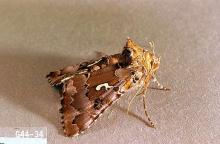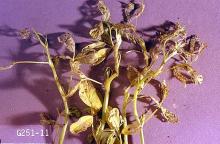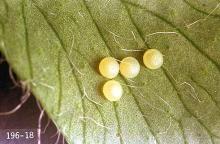Includes alfalfa looper (Autographa californica), cabbage looper (Trichoplusia ni)
Pest description, crop damage and life history
See:
Common Pests of Vegetable Crops
Pest monitoring A sweep net can be used to sample for large larvae. Take a minimum of 100 sweeps divided into groups of 10 in different parts of the field and along the margins. Sequential sampling that involves fewer samples, and presence-absence sampling that does not involve counting, also may be used.
Pheromone traps can be used to monitor for the emergence of adult male moths. Alfalfa loopers are trapped more often than cabbage loopers, sometimes leading to misreading which looper is the primary pest.
Management-biological control
Cabbage loopers have many natural enemies that may keep them below economic levels if they are not killed by insecticide treatments for other pests. These include several important, naturally occurring parasitoids. A nucleopolyhedrovirus is also important under certain circumstances.
Be sure to monitor for natural enemies. If looper populations are close to treatment thresholds, but you find a significant percentage of parasitized or disease-killed individuals, delay treatment for a few days to see if these natural controls will bring populations down on their own. If treatment is necessary, Bacillus thuringiensis insecticide minimizes injury to natural enemies.
Management-cultural control
Use row covers after planting to prevent egg-laying by adults. Rotate plantings, and harvest without delay at the end of the season. Remove plant debris from the field at the end of harvest.
Management-chemical control: HOME USE
- acetamiprid
- azadirachtin (neem oil)-Some formulations are OMRI-listed for organic use.
- Bacillus thuringiensis var. kurstaki (Btk)-Some formulations are OMRI-listed for organic use.
- bifenthrin (as a mix with zeta-cypermethrin)
- cyfluthrin
- kaolin-Applied as a spray to foliage, it acts as a repellent to some insect pests. Some formulations are OMRI-listed for organic use.
- malathion
- permethrin
- plant essential oils (rosemary, etc.)- Some formulations are OMRI-listed for organic use.
- pyrethrins-Some formulations are OMRI-listed for organic use.
- spinosad-Some formulations are OMRI-listed for organic use.
- zeta-cypermethrin
Management-chemical control: COMMERCIAL USE
- alpha-cypermethrin (Fastac EC) at 0.02 to 0.025 lb ai/A. PHI 1 day. REI 12 hr. Retreatment interval 7 days. Do not exceed 0.075 lb ai/A per season. Washington only.
- Bacillus thuringiensis (Javelin) at 0.12 to 1.5 lb/A. PHI 0 days. REI 4 hr. Acts slowly; may need multiple applications. Add an appropriate spreader-sticker to enhance control. Most effective on small larvae. Some formulations are OMRI-listed for organic use.
- beta-cyfluthrin (Baythroid XL) at 0.013 to 0.019 lb ai/A. PHI 0 days. REI 12 hr. Retreatment interval 7 days. Do not exceed 0.1 lb ai/A per season.
- beta-cyfluthrin/imidacloprid (Leverage 360) at 0.07 lb ai/A. PHI 7 days. REI 12 hr. Retreatment interval 7 days. Do not exceed 0.1 lb ai/A beta-cyfluthrin or 0.2 lb ai/A imidacloprid per season.
- bifenthrin (Brigade WSB) at 0.033 to 0.1 lb ai/A. PHI 40 days. REI 12 hr. Retreatment interval 7 days. Do not exceed 0.4 lb ai/A per season.
- bifenthrin/Avermectin (Athena) at 0.05 to 0.12 lb ai/A. PHI 40 days. REI 12 hr. Retreatment interval 7 days. Do not exceed 0.056 lb ai/A avermectin or 0.4 lb ai/A bifenthrin per year. Limit 2 treatments.
- bifenthrin/imidacloprid (Brigadier) at 0.08 to 0.096 lb ai/A. PHI 40 days. REI 12 hr. Do not exceed 0.24 lb ai/A imidacloprid and 0.24 lb ai/A bifenthrin per season. Retreatment interval 7 days.
- borate complex (Prev-Am) at 0.4% solution. Apply to complete coverage. REI 12 hr. OMRI-listed for organic use.
- Chromobacterium subtsugae (Grandevo) at 0.3 to 0.9 lb ai/A per 100 gal. PHI 0 days. REI 4 hr. OMRI-listed for organic use.
- chlorantraniliprole (Coragen) at 0.045 to 0.098 lb ai/A as soil, chemigation or foliar treatment. PHI 1 day. REI 4 hr. Retreatment interval 3 days
- cyclaniliprole (Harvanta 50SL) at 0.036 to 0.054 lb ai/A. PHI 1 day. REI 4 hr. Retreatment interval 5 days. Do not exceed 0.22 lb ai/A per year.
- cyfluthrin (Tombstone) at 0.025 to 0.038 lb ai/A. PHI 0 days. REI 12 hr. Retreatment interval 7 days. Do not exceed 0.2 lb ai/A per season.
- cyfluthrin/imidacloprid (Leverage 2.7) at 0.08 lb ai/A. PHI 7 days. REI 12 hr. Retreatment interval 7 days. Do not exceed 0.17 lb ai/A cyfluthrin or 0.24 lb ai/A imidacloprid per year.
- emamectin benzoate (Proclaim) at 0.01 to 0.015 lb ai/A. PHI 7 days. REI 12 hr. Retreatment interval 7 days. Do not exceed 0.09 lb ai/A per season. Do not graze.
- flubendiamide/buprofezin (Vetica) at 0.21 to 0.42 lb ai/A. PHI 1 day. REI 12 hr. Limit 2 treatments. Retreatment interval 7 days. Do not exceed 0.83 lb ai/A per year.
- GS-omega/kappa-Hxtx-Hv1a (Spear Lep) at 0.8 lb ai/A. PHI 0 days. REI 4 hr. Do not exceed 2 lb ai/A per year.
- indoxacarb (Avaunt) at 0.065 lb ai/A. PHI 3 days. REI 12 hr. Do not exceed 0.26 lb ai/A per crop. Retreatment interval 3 days.
- methomyl (Lannate SP) at 0.45 to 0.9 lb ai/A. PHI 7 days. REI 48 hr. Do not exceed 3.6 lb ai/A per season. Limit 8 treatments per year. Do not apply to seedlings less than 3 inches wide or when temperatures are below 32°F.
- methoxyfenozide (Intrepid 2F) at 0.06 to 0.12 lb ai/A early-season, or 0.12 to 0.16 ai/A mid- to late-season. REI 4 hr. PHI 1 day. Do not exceed 1 lb ai/A per season.
- permethrin (Loveland Permethrin) at 0.05 to 0.2 lb ai/A. PHI 1 day. REI 12 hr. Retreatment interval 3 days. Do not graze or feed treated crop refuse to livestock. Do not exceed 0.6 lb ai/A per season.
- spinetoram (Radiant SC) at 0.039 to 0.078 lb ai/A. PHI 1 day. REI 4 hr. Retreatment interval 4 days. Do not exceed 0.266 lb ai/A per season. Limit 6 treatments per season. Do not apply to seedling leafy vegetables grown for transplant within a greenhouse, shade house, or field plot. Cabbage looper only.
- tebufenozide (Confirm 2F) at 0.09 to 0.12 lb ai/A early-year, or 0.12 lb ai/A mid- to late-year. PHI 7 days. REI 4 hr. Do not exceed 0.12 lb ai/A per application or 0.625 lb ai/A per season. Reapplication on a 10- to 14-day schedule may be necessary under heavy infestations. Use of a spreader-binder is recommended.
- thiamethoxam/chlorantraniliprole (Durivo) at 0.2 to 0.257 lb ai/A applied to the soil. PHI 30 days. REI 12 hr. Do not exceed 0.172 lb ai of thiamethoxam or 0.2 lb ai of chlorantraniliprole per acre per growing season.
- zeta-cypermethrin (Mustang) at 0.04 to 0.05 lb ai/A. PHI 1 day. REI 12 hr. Retreatment interval 7 days. Do not exceed 0.3 lb ai/A per season.
These products contain commonly used active ingredients for control of looper in spinach. There are other materials available. Please consult a licensed crop advisor for additional recommendations.





